Interviews
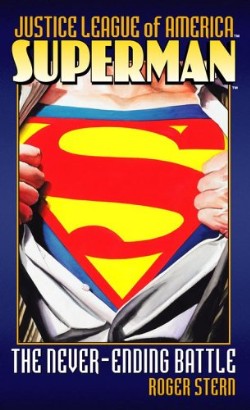
An Interview with Roger Stern
Conducted by Michael Bailey for the Superman Homepage.[Date: December 16, 2005]
I'm going to date myself a little here, but back in the fall of 1988 I was twelve years old and entering the seventh grade at Eyer Junior High School in Macungie, Pennsylvania. For nearly two years I had made a concerted effort to collect the Superman line of comics and suddenly a major shift had occurred. John Byrne, the writer/artist that got me into collecting the books in the first place, was gone and while Jerry Ordway was still on Adventures of Superman, some guy named Roger Stern was writing Superman with art by Kerry Gammill.
This kind of change was new to me. Being an inexperienced comic collector I wasn't used to creative shifts. It didn't take long for me to get used to Roger Stern's writing style and become a fan of the man's efforts. His version of Clark Kent and the rest of the Superman cast was similar to what John Byrne had done with the character, but different enough to be distinctive. He obviously had a strong vision for the character and his writing carried that through.
This wouldn't have been a surprise to me if I had been more familiar with Roger's body of work. Before becoming a comics professional he published a fanzine called Contemporary Pictorial Literature with fellow fan and future professional Bob Layton. This led to his work on another fanzine called Charlton Bulleye and eventually he caught the notice of Tony Isabella, editor of Marvel's FOOM (Friend of 'Ol Marvel) where he contributed a number of articles. In 1975 he broke into Marvel Comics as an assistant editor, then as an editor and eventually a writer. For thirteen years Roger Stern was prolific and between his editing and writing chores he touched nearly every character in the Marvel Universe. He had stretches on Amazing Spider-Man, Dr. Strange, Incredible Hulk and Avengers along with a memorable but much too short run on Captain America with John Byrne.
In 1988 he moved to DC after a disagreement with his editor on the Avengers. In addition to writing Superman and the character's two page feature in Action Comics Weekly Roger wrote the Power of the Atom series and created the Will Payton version of Starman. After Action Comics switched back to a monthly status in 1989 Roger remained with that title until 1994. In 1995 he came back to the character with the quarterly Superman: The Man of Tomorrow series, which he stayed on until 1998. He also worked for Marvel during this period most notably on Avengers Forever and Marvel: The Lost Generation.
In addition to being a talented writer Roger Stern is also a heck of a nice guy. I had the pleasure of meeting him on two occasions; once in 1990 at a Dreamscape Comics in Bethlehem, PA and again in 1992 at an anniversary party at Beachead Comics in Allentown, PA. He was the first comic book professional I ever met and he was one of the nicest. (I even got my name in a local newspaper that was covering the 1990 store signing, which was a pretty big deal for me at the time. I still have that article in my files.) Recently he was kind enough to participate in an e-mail interview with me regarding his days working on the Man of Steel.
Q: What comic books did you read as a kid? What led you to want to become a comic book writer?
Roger Stern: I read just about everything that was then readily available... which in Central Indiana in the late 1950s meant mainly Dell and DC, with an occasional Archie, Charlton, or Harvey comic thrown into the mix. Comics distribution was pretty hit or miss back then. I didn't even see any Marvels until I was in my teens. (And "Marvel," as we came to know it, didn't really exist when I first started reading comics.)
So, I started out reading a lot of the great Carl Barks stories as they originally appeared in WALT DISNEY'S COMICS & STORIES. From there, I "graduated" to the Superman titles, BATMAN, DETECTIVE, and Julius Schwartz's revivals of FLASH, GREEN LANTERN, and all the rest that followed. I can still remember buying THE BRAVE & THE BOLD #28, with the first appearance of the Justice League. That was one of three comics I read so often that the cover came apart and fell off. (Just for the record, the other two were SPACE ADVENTURES #33 with Steve Ditko's first Captain Atom story, and Simon & Kirby's THE DOUBLE LIFE OF PRIVATE STRONG #1.)
As far as wanting to become a comics writer... I have to confess that I never really gave that much thought when I was growing up. I'd always expected to have a career in the sciences, and first studied engineering in college. I eventually changed curricula to earn a degree in telecommunications and went to work in radio. Comics writing was something I just sort of stumbled into.
Q: What was your first published comic book work?
RS: Professionally, you mean? My first published comic book work would have been the Marvel reprint comics that I edited. My first few months at Marvel, I picked the stories that appeared in TOMB OF DARKNESS, CHAMBER OF CHILLS, WEIRD WONDER TALES, MARVEL TALES, RAWHIDE KID, TWO-GUN KID, KID COLT OUTLAW, and proofread them to make sure they were in good enough shape to reprint -- but I couldn't point to one particular issue and say, "This was the first." The comics writing of mine that first saw print was probably in MARVEL PRESENTS #8, starring the Guardians of the Galaxy.
Q: How did you come to work for Marvel Comics in the mid-'70s?
RS: I was offered a chance to test for a proofreading position at Marvel. And I must have passed, because I was hired as an assistant editor. I started out assembling those reprint titles and proofing letters pages.
Q: What led you to move from Marvel to DC in 1988?
RS: I was fired from the AVENGERS for disagreeing with my editor, and my best options at the time were all at DC... mainly in the form of Mike Carlin, who put me to work writing Superman stories.
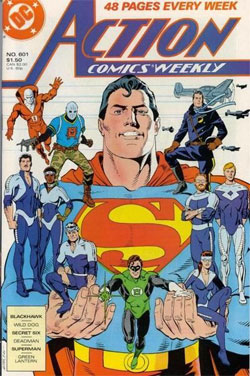 Q: Your initial work on Superman was the two-page Superman feature in ACTION COMICS WEEKLY? How did that assignment come about?
Q: Your initial work on Superman was the two-page Superman feature in ACTION COMICS WEEKLY? How did that assignment come about?
RS: Mike offered me that. At the time, John (Byrne) was writing and drawing SUPERMAN and writing ADVENTURES OF SUPERMAN, as well as three four-issue miniseries (WORLD OF KRYPTON, WORLD OF SMALLVILLE, and WORLD OF METROPOLIS)... and I seem to recall that there were plans for a while to publish SUPERMAN biweekly. Anyway, right around that time, DC decided to experiment with ACTION COMICS, turning it into a weekly, multi-feature anthology, but they still wanted Superman to be one of the features, so Mike asked me to write the weekly strip. I was basically writing a Superman Sunday newspaper strip. I got to see my stories drawn by Curt Swan and Murphy Anderson, which was a great thrill. Some of Curt's earliest Superman work, after all, had been for the Superman newspaper strip, and he personally called me to tell me how much he enjoyed drawing my feature. And Murphy, of course, had worked on Buck Rogers and is still a big fan of the classic newspaper adventure comics. He plugged into it immediately.
Q: What led you to take over for John Byrne on SUPERMAN in the summer of 1988?
RS: I had already written a SUPERMAN ANNUAL and was plotting two issues of SUPERMAN to buy John some breathing room, when he decided to leave the series. Those two issues became SUPERMAN #23 and #24, the first of my run.
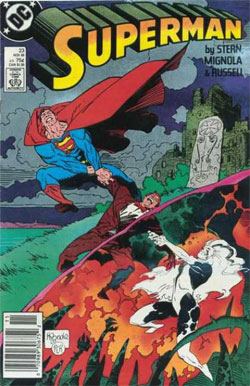 Q: What were your influences in regards to Superman? What version of the character was your favorite?
Q: What were your influences in regards to Superman? What version of the character was your favorite?
RS: Since my earliest exposure to Superman was The Adventures of Superman television series, that has been a major influence over the years. Even today, whenever I write a line of dialogue for Perry White, I can hear an echo of John Hamilton's voice in the back of my head. Growing up, I also enjoyed a lot of the Weisinger era stories -- especially those written by Jerry Siegel and Bill Finger -- and the early Schwartz era stories written by Denny O'Neil. But I chiefly followed what John had established in all of his work since MAN OF STEEL. That was the Superman I was writing, and that was the one I most enjoyed.
Q: When you first took over SUPERMAN what was your take on Superman, Clark Kent and his supporting cast?
RS: I saw Clark Kent as this idealistic young guy from the Great Plains who had tramped around the world for a while, before settling down to a career as a journalist and columnist for the greatest metropolitan newspaper in the United States. He's this very clever, very urbane writer who has never lost the ideals that his parents instilled in him. He's also harboring a deep, deep secret... Clark Kent looks like a normal Earthman, but he's actually an alien being, conceived on another planet.
Superman, on the other hand, has no obvious secrets. How could he? He's not like the Batman, after all. Superman doesn't wear a mask. His face is hanging out there for everyone to see. Superman is larger than life. He has a great sense of humor, and he's slow to anger. But he does have a temper and you do not want to get on his bad side! There was the tag line from the old Boston Blackie radio program, where Boston was described as a "friend to those who have no friend... an enemy only to those who would make him an enemy." That sums up Superman pretty well, too.
Now, Lois Lane is an Army brat who grew up seeing a lot of the world, largely because her father kept uprooting the family every few years and moving them across continents. She spent much of her youth rebelling against authority -- at first in the person of her father. (Sam Lane, as you may recall, made no bones about the fact that he would have preferred fathering sons. What a peach of a guy.) As an adult, Lois is still a bit of a rebel, and she does not suffer fools gladly.
Jimmy Olsen, of course, is this earnest young kid... fairly bright, but always getting himself into trouble.
And Perry White is an irascible old pro with printer's ink flowing through his veins.
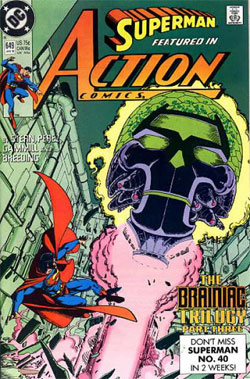 Q: After the EXILE story arc you switched from SUPERMAN to ACTION COMICS. What led to this?
Q: After the EXILE story arc you switched from SUPERMAN to ACTION COMICS. What led to this?
RS: With ACTION returning as a regular Superman book, we were going from two to three monthly titles, and George Perez came on board, originally planning to write one title and draw another, but assignments just wound up getting shuffled around a bit. Jerry had been drawing and plotting or co-plotting Superman stories since the relaunch, so it just made sense for him to take over SUPERMAN. George and I had wanted to work together for some time, so we wound up on ACTION. And Dan Jurgens, who had already written and drawn a few Superman stories, worked first with George and then solo on ADVENTURES.
Q: You were present at the first Super-Summit, where the creative teams would get together to discuss what was coming up in the Superman line of books. What were these meetings like? Were there any particularly memorable or amusing incidents? Did they help or hinder you as a writer on Superman?
RS: Each summit was a little different. Looking back, I wish I had kept a journal of them.
I remember that the first took place over dinner at the Watermark restaurant in Cleveland, Ohio... Superman's real birthplace. Present were Mike, Jerry, George, Kerry Gammill, my wife Carmela, and the great Curt Swan. George, of course, was bubbling over with ideas, but we all put our two cents in.
Curt seemed especially pleased to be asked his opinion. I believe it was the first time he'd ever been included in such a brainstorming session. Can you believe it? There was Curt Swan, a consummate artist and storyteller who spent much of his adult life breathing life into Superman, and he'd never before been given an opportunity to express himself like that.
Anyway, as I said, they were all a little different. They took place everywhere from Manhattan to the Twin Cities to Orlando, Florida (that time, we all got to guest-star in an episode of Superboy). We would gather together in a room - usually a room with no windows - and toss ideas back and forth for a couple of days. We would always leave with at least a year's worth of stories. It was a great help for the writers and the artists, and was, I think, the foundation of a decade's worth of great Superman comics.
Q: Of the three (and then four) writers on the Superman titles you seemed to handle Lex Luthor more than the others. You wrote his "death" and then re-birth as a clone, his fall from grace that resulted in the destruction of Metropolis and his eventual return in the pages of SUPERMAN: THE MAN OF TOMORROW. Was there any kind of "dibs" you had on Lex or was it a happy accident that you did so much with the character?
RS: No one had dibs on anyone, but some of us did sort of gravitate to certain cast members. Lex was always a presence in the books, even in his absence. As I recall, we had all discussed Luthor's radiation poisoning and the possibilities of a death scene -- preferably faked, as none of us wanted to get rid of him forever. I hit on the idea of using Dabney Donovan to grow Lex a new, younger body. And everyone loved the whole "They Saved Luthor's Brain!" idea. Things just sort of grew from there.
Q: What was it about Lex that you enjoyed writing? Were there any other villains you enjoyed working with?
RS: Lex is the nasty side of humanity... supremely arrogant and egotistical. He saw himself as better than everyone else, and therefore above the laws that govern others.
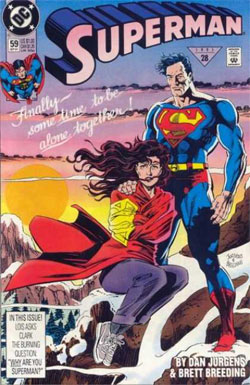 Q: How did Lois and Clark's engagement come about?
Q: How did Lois and Clark's engagement come about?
RS: Jerry Ordway should get the credit for that. The original plan for SUPERMAN #50 had been that Lois would turn down Clark's proposal. But when Jerry was plotting that issue, it just didn't feel right to him. As I recall, he was discussing it with Mike and it occurred to him to ask, "What if she says 'yes'?" The two of them mulled it over for a while, and then Mike called me and repeated that question, "What if she says 'yes'?"
As I recall, the first word out of my mouth was "Wow!"
Q: In late 1990 the triangle numbering system (or the Never-Ending Battle format as some people have called it) was instituted. What was it like coordinating with two and then three other writers?
RS: Fun, actually. Challenging at times, but I've always loved a challenge. Besides, my early tenure at Marvel had taught me a lot about coordinating stories with others. That was the name of the game at the old House of Ideas.
Q: Around the same time that you started on Superman you created the Will Payton version of Starman. What led you to create this character?
RS: I got a call from Mike Gold, who asked me if I was interested in creating a new Starman for DC. He basically gave me carte blanche to start with the name and go from there.
It was a wonderful opportunity to make a character up out of whole cloth... and a whole lot of fun, working with Tom Lyle, to create Will's world. It was probably the most "Marvel" work I did for DC. Unfortunately, they didn't know what to do with it.
Q: How did the ecologically themed SUPERMAN: FOR EARTH come about?
RS: As I recall, Jenette Kahn was interested in seeing a Superman eco-story, perhaps as a tie-in to Earth Day. I saw it as an opportunity to write a stand-alone Superman story that would maybe make people stop and think about our world. I'm still very proud of it. Of course, it was allowed to go out of print long ago, and most people aren't even aware that it exists.
Q: You wrote a lot of Superman-related reference material. How did you land the assignments to write both the SUPERMAN: THE MAN OF STEEL sourcebook for Mayfair Games and the majority of the Superman cast entries in the 1990 loose leaf binder WHO'S WHO series?
RS: I think that I'd started writing the WHO'S WHO Superman entries first. And it's funny... I hadn't intended to write so many of them. In fact, I'd initially just asked to write the Starman-related entries... which of course someone else wound up writing. Anyway, I kept getting assignments to write Superman entries, and when the Mayfair assignment came along, Mike Carlin figured, "Hey, Roger already knows all this stuff, we should have him write it."
Unfortunately, there was then an editor at Mayfair, who tried to reconcile Superman's new continuity with what he personally liked from the older stories by mixing in some older, contradictory material. Fortunately, his replacement caught most of that and eliminated it... with my help.
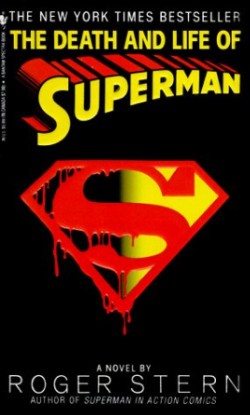 Q: What was it like for you during the death and return of Superman?
Q: What was it like for you during the death and return of Superman?
RS: Busy. Very busy. Extremely busy. After all, in addition to writing a new issue of ACTION COMICS every month, I was also adapting my work -- and everyone else's -- into The Death and Life of Superman, a novelization of the entire storyline.
Q: How did you get the assignment to write the novelization?
RS: Again, that was thanks to Mike Carlin, from whom all my Superman blessings flowed. He figured that it would be best to have someone on the inside write the book, and he suggested me for the job. And being young and foolhardy, I agreed to write it.
Q: Was it your intention to show how a "darker" Superman doesn't work when you chose the Eradicator as your Superman during the REIGN OF THE SUPERMEN? Did you buy the DC DIRECT action figure of the character?
RS: I'm not really that into action figures myself, but DC was nice enough to send me one. But to answer your first question, I saw the Eradicator as an opportunity to show how a darker hero could work... but also how, ultimately, it wouldn't be Superman. Superman can deal with weighty or "dark" subjects, but he is not a dark character.
Q: What led you to give up writing ACTION COMICS in 1994?
RS: I really needed a break. At that point, I had been writing Superman stories for seven years, and had burned the candle at both ends while writing the novel. I had gotten by on about four-to-five hours of sleep a night for the final two months on the novel, and of course, I was still writing the monthly ACTION COMICS through it all. Anyway, the other writers wanted to more or less write Lex out of the role he'd had since the series relaunch, and issue #700 of ACTION was turning into this great ending, so I figured that there was a good place to stop... for a while, at least.
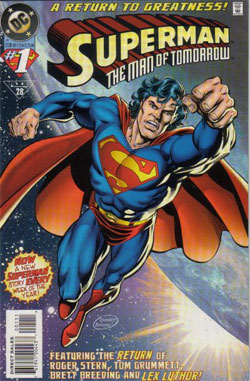 Q: You came back to Superman in 1995 with SUPERMAN: THE MAN OF TOMORROW. What led to that assignment?
Q: You came back to Superman in 1995 with SUPERMAN: THE MAN OF TOMORROW. What led to that assignment?
RS: Back when I was getting ready to take my leave from ACTION, Mike (Carlin) was already making noises about how he wanted to get me back on the Super-team after my break... and he was as good as his word. See, even with the four monthly Superman titles, there were still four weeks during the year when no new Superman work appeared. The solution was the sort-of quarterly SUPERMAN: THE MAN OF TOMORROW. My original suggestion was that I write a double-sized book with stories set earlier in Superman's career, during the seven or so years that had passed between his public debut in MAN OF STEEL #1 and SUPERMAN #1. And, while there was some initial interest in that format, by the time we got around to actually producing the comic, it was decided to make S:MOT part of the regular triangle numbering.
Q: What was it like writing a quarterly book?
RS: Writing the book wasn't much more of a hassle than any other assignment. Since it would come out only four times a year, I did my best to write stories that stood on their own, yet still reflect what was going on in the other titles.
Q: What led you to give up that assignment?
RS: It was really starting to disappear around me. DC was producing more and more special projects for the months with five shipping weeks, and MAN OF TOMRROW was getting pre-empted more and more. And when the JLA office started dictating how Luthor should be written, I thought it best that I step away from the book before the editorial wars turned the whole thing into a train wreck.
Q: What was the inspiration for SUPERMAN: A NATION DIVIDED? Are you a Civil War buff? Why did you name the character Atticus Kent? Was the Lone Ranger reference at the end there from the beginning?
RS: Atticus... well, I was looking for a name that evoked an earlier time. On some level I was probably remembering Gregory Peck's portrayal of Atticus Finch from the film version of To Kill a Mockingbird. (How many of you remember that Dan Jurgens established To Kill a Mockingbird as Clark's favorite movie? Let's see some hands.) I wouldn't say I'm a Civil War buff, but many of the players -- Lincoln, especially -- interest me.
And as for the Lone Ranger... what, just because Kent rides off into the sunset on the great horse Silv... er, I mean... on a great silver horse?
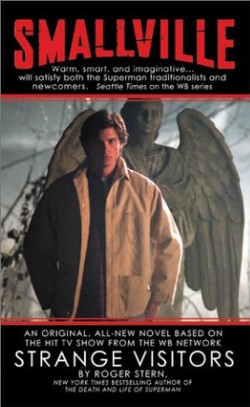 Q: How did you come to write your SMALLVILLE novel? Are you a fan of the series?
Q: How did you come to write your SMALLVILLE novel? Are you a fan of the series?
RS: I was looking for comics work -- and not having much success - when I got a call from Steve Korte at DC, asking me if I'd be interested in writing an original novel based on the Smallville series. I was a little uncertain at first. At the time, all I could recall of writing the earlier novel was a blur of time spent at a keyboard. That had been nine years earlier, but it still haunted me; I had virtually lost an entire season from my life. Still, Steve was persistent, and he eventually convinced me to write my second novel. And now, I'm glad that I did.
And, yes, I quite enjoyed the television series while I was following it. I haven't caught much of it in recent seasons, but then I don't watch very much network TV anymore.
Q: How did you come to write the Superman entry in the JUSTICE LEAGUE series of novels? Do you prefer writing novels to writing comics?
RS: In that case, Charlie Kochman, who had been my editor on The Death and Life of Superman, called and wanted me to write the book which became Superman: The Never-Ending Battle. It was great working with him again, and I'm very happy with the way the book turned out. I just wish the book publisher had promoted it. Much of the potential audience for the series has never heard that it exists.
And with that third book under my belt, I've really started to enjoy writing novels. I still like to write comics, of course. I've also written for radio, television, the stage, and the computer screen. I just enjoy writing in general.
Every medium has its own advantages and limitations. For example, in comics your limitation is space -- you have only so many pages, so many panels in which to tell your story. In radio or television, the limitation is time -- you have only so many minutes to tell the tale. In comics, if you want a really awe-inspiring explosion, you simply ask your artists to draw one. In the cold type of prose, the writer is out there on his or her own, using all the skills they have to sell that explosion. On the other hand, in prose you can have long, meaty dialogues between characters that would become a long, boring series of talking head scenes in a comic book. It all balances out.
Q: What are your thoughts on the new Superman film?
RS: I haven't heard much about it. I hope they do a good job.
Q: Do you keep current with the Superman titles?
RS: I do try to keep up with the new stories. DC has been kind enough to keep me on their comp list. I eventually see the DC Comics that you have, a month or more after they go on sale.
Q: Have you read Mark Waid's BIRTHRIGHT and, if so, what did you think of the changes he made to what had become the established origin begun by John Byrne in 1986?
RS: I've read part of BIRTHRIGHT so far, and I quite understand why DC might have wanted to establish a back-story that reflects some of the Smallville continuity. Superman has an ever-evolving mythology, after all, and there are probably more people who watch Smallville in any given week than read all the Superman comics produced in the past year.
On the other hand, next year there is going to be that new Superman movie you mentioned. And if that it is going to be different in tone from the television program -- and I can't imagine it not being different -- then what do you do? Change the back-story of the comics yet again? I worry that the pace of these changes might be accelerating out of control. I've had discussions with other writers, where they've asked me, "Have these two characters ever met?" Sometimes, I've had to answer, "Well, as of last month, they had. As of today, I'm not sure."
Any changes to a character should be handled carefully, and with some thought as to how they might affect the future. That's rarely easy, but it is all part of the job.
Q: Finally, you have written both Superman and Spider-Man, two of the most iconic characters in comics. To you, what do these characters have in common and what sets them apart?
RS: Spider-Man is a wiseass, whereas Superman sense of humor is more wry, more urbane. Spider-Man is the kind of guy who would start a pie fight, just to outrage his opponent; Superman would walk right through the pie fight and never get hit.
Spider-Man is the hero you can imagine yourself becoming: you have one stupid accident, and you wind up with weird powers. I mean, let's be honest, sticking to walls is a weird power... kind of cool, but still weird. Plus, if you're Spider-Man, it doesn't matter what you look like -- your face is completely covered by that mask!
But when the going gets rough, Superman is the hero that you want to be. Heck, given a choice, he's the hero that Spider-Man would want to be! Superman doesn't spend half his life wondering if he's doing the right thing; he's too busy, doing the right thing. I still recall how, after the crew of the Challenger space shuttle was lost, there was a young boy that Life magazine quoted as saying, "I wish I had been Superman, so I could have saved them." I can't think of a better way to explain Superman's appeal.
Superman is very self-aware, and Spider-Man is very self-doubting. But when you get down to the nitty-gritty, both are very aware of the fragility of life, and of how quickly everything can change. They are both good people who do the right things for the right reasons, even though Spider-Man's reasoning is sometimes a little off kilter. And neither one is the least bit pretentious.
This interview is Copyright © 2005 by Steven Younis. It is not to be reproduced in part or as a whole without the express permission of the author.
Interviews
Introduction
The Superman Homepage has had the pleasure of interviewing various Superman Comic Book creative people about their work.
Question and Answer Interviews:
- Interview with writer Marv Wolfman about Man and Superman: The Deluxe Edition (November 2019)
- Interview with artist Claudio Castellini about Man and Superman: The Deluxe Edition (November 2019)
- Interview with artist Joe Staton about working on Superman properties over the years (November 2019)
- Interview with Christopher Priest about the Superman vs. Deathstroke story in Deathstroke #8 (November 2016)
- Interview with Sterling Gates about the 'Adventures of Supergirl' digital-first comic book series (January 2016)
- Interview with J. Michael Straczynski about “Superman: Earth One - Vol. 3” - Writer J. Michael Straczynski talks to us about the third volume in the “Superman: Earth One” graphic novel series (February 2015)
- Interview with Jim Krueger - Writer Jim Krueger talks to us about his “The Dark Lantern” story in the “Adventures of Superman” comic book title (November 2013)
- “Smallville: Season 11” Interview with Bryan Q. Miller - Writer Bryan Q. Miller talks to us about his work on the “Smallville: Season 11” comic book title (October 2012)
- “Supergirl” Interview with Mahmud Asrar - Artist Mahmud Asrar talks to us about his work on the monthly “Supergirl” comic book title (July 2012)
- “Superman/Batman” Interview with Joshua Hale Fialkov - Joshua Hale Fialkov answers our questions about “The Secret” 3-part story in “Superman/Batman” #85-87 (July 2011)
- “Supergirl” Interview with Sterling Gates - Sterling Gates answers our questions about where Supergirl is headed post “War of the Supermen” (June 2010)
- “Supergirl” Interview with Sterling Gates & Jamal Igle - Adam Dechanel chats with the “Supergirl” comic book team about the Maid of Might (March 2010)
- Behind the Scenes of the Super Friends - Four part indepth look at the “Super Friends” comic book title with artists J. Bone and Stewart McKenny (February 2010)
- Interview with Landry Q Walker and Eric Jones - The writer and artist discuss Supergirl: Cosmic Adventures in the Eighth Grade (May 2009)
- Interview with Elliot S! Maggin - Legendary Superman writer and novelist discusses his career (January 2009)
- Interview with J. Bone - Artist discusses Super Friends comic book (November 2008)
- Interview with Mark Bagley (September 2008)
- Interview with J. Torres - Writer discusses Legion of Super Heroes in the 31st Century #18 (September 2008)
- Interview with Jake Black (May 2008)
- Interview with Cary Bates (June 2008)
- Interview with Jack Briglio - Writer discusses Legion of Super Heroes in the 31st Century #14 (May 2008)
- Interview with Ken Pontac - Writer discusses Justice League Unlimited #44 (May 2008)
- Interview with Karl Kerschl (April 2008)
- Interview with J. Torres - Writer discusses Legion of Super Heroes in the 31st Century #13 (April 2008)
- Interview with J. Torres - Writer discusses Legion of Super Heroes in the 31st Century #11 (February 2008)
- Interview with Fabian Nicieza - Writer on Superman comic books (June 2007)
- Interview with Danny Fingeroth - Writer of the book Superman on the Couch (May 2007)
- Interview with Jesse McCann - Writer on the Krypto The Superdog comic books (December 2006)
- Interview with Matt Haley - Artist on the Superman Returns comic book movie adaptation (November 2006)
- Interview with Ethan Van Sciver - Artist on Superman/Batman (September 2006)
- Interview with Mark Verheiden on taking over the writing duties on Superman/Batman (April 2006)
- Interview with Matt Idelson on taking over as Superman group editor (March 2006)
- Interview with Jeph Loeb on Sam and “Superman/Batman #26” (February 2006)
- Interview with Roger Stern (December 2005)
- Interview with Marv Wolfman (November 2005)
- Interview with Gail Simone (May 2005)
- Interview with Greg Rucka (April 2005)
- Interview with Brad Meltzer [Identity Crisis] (January 2005)
- Interview with Glenn Whitmore (November 2004)
- Interview with Jeph Loeb (September 2004)
- Interview with Karl Kerschl (September 2004)
- Interview with Ron Garney (September 2004)
- Interview with Greg Rucka and Matthew Clark (May 2004)
- Interview with Ed McGuinness (March 2004)
- Interview with Brad Meltzer [Identity Crisis] (March 2004)
- Interview with Mark Millar [Superman: Red Son] (March 2003)
- Interview with Min S. Ku (September 2001)
- Interview with Jeph Loeb (May 2001)
- Interview with Joe Casey (April 2001)
- Interview with Mike S. Miller (September 2000)
- Interview with Denis Rodier (August 2000)
- Interview with Grant Morrison (December 1999)
- Interview with Mark Millar [Part 2] (November 1999)
- Interview with Mark Millar [Part 1] (April 1999)
Interviews/Articles:
- “Superman vs. Terminator” - A Chat with Fight Promoter Alan Grant. (January 2000)
- Superman: The Dailies (1939-1940) Graphic Novel Review.
- The Rebirth of Superman (Part 1) - Superman is reborn... again.
- The Rebirth of Superman (Part 2) - Eddie Barganza on taking the character in a new direction.
- The Rebirth of Superman (Part 3) - Jeph Loeb discusses writing the Man of Steel.
- Lex Luthor For President - Forget Superman. An updated Luthor's new enemies are Gore and Bush.
- Superman: Last Son of Earth - Steve Gerbern Interview - The writer discusses flip-flopping the Man of Steel's origin. (August 2000)
Krypton Club Interviews:
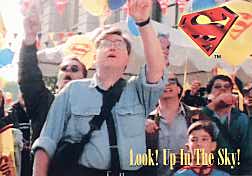 When “Lois & Clark” started production in 1993, there was an obvious relationship between the comic book people and the Hollywood people.
When “Lois & Clark” started production in 1993, there was an obvious relationship between the comic book people and the Hollywood people.
A trade paperback “Lois and Clark: The New Adventures of Superman”, was published, with Dean Cain and Teri Hatcher on the cover. It included reprints of comic book stories that were the inspiration for “Lois & Clark”, helping to define the characters. Comic's included are: The Story of the Century (Man of Steel miniseries #2), Tears for Titano (Superman Annual #1), Metropolis - 900 mi (in SUP #9), The Name Game (SUP #11), Lois Lane (in ACT #600), Headhunter (AOS #445), Homeless for the Holidays (AOS #462), The Limits of Power (AOS #466), and Survival (ACT #665).
A number of comic book writers and artists had roles as extras in the episode “I'm Looking Through You” (Season one, episode 4). Their presence was immortilized in the Sky Trading Card #34.
Craig Byrne, president of the online “Lois & Clark” fanclub The Krypton Club, carried out a series of interviews with comic book writers. The interviews are reprinted with permission of the Krypton Club.
- Interview with Roger Stern (June 1995)
- Interview with John Byrne (June 1995)
- Interview with Mike Carlin (July 1995)
